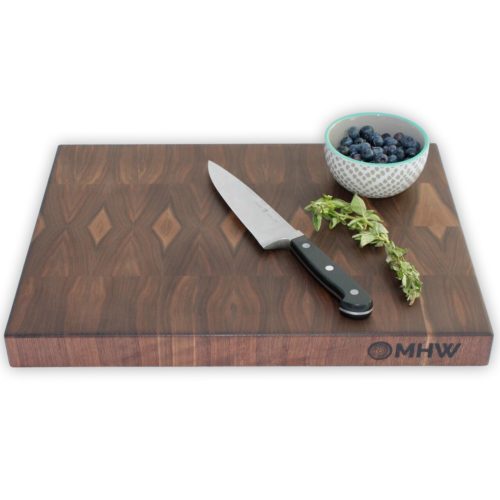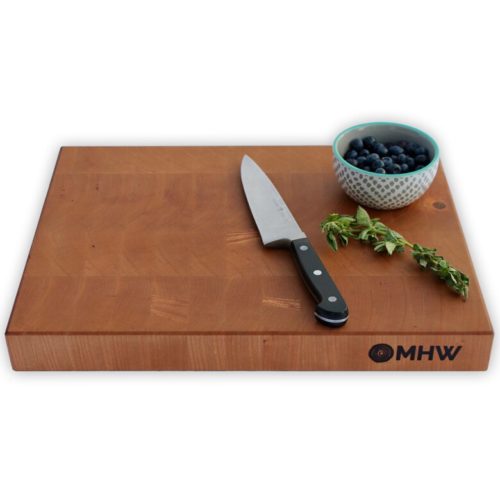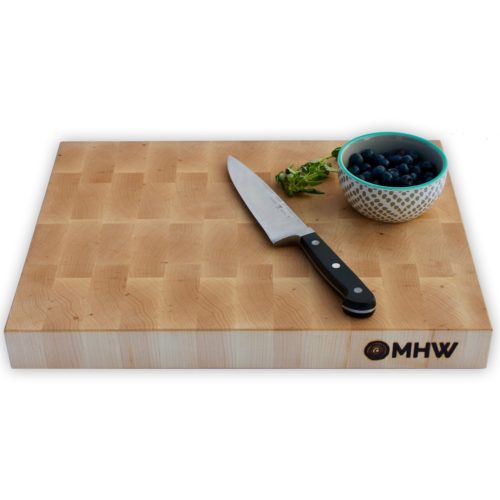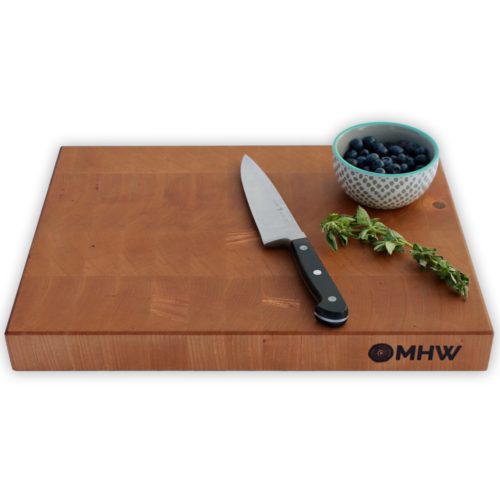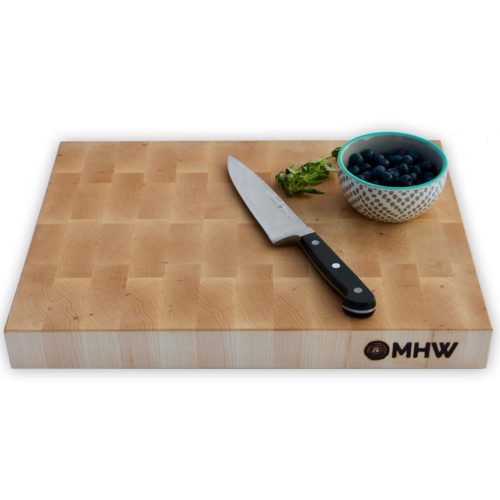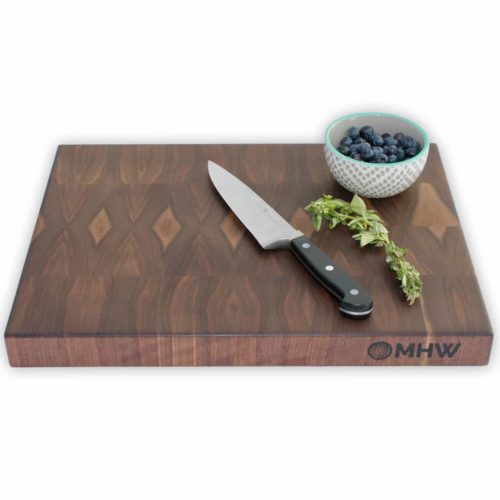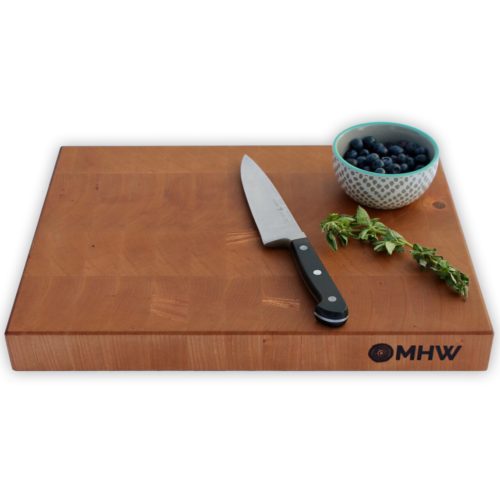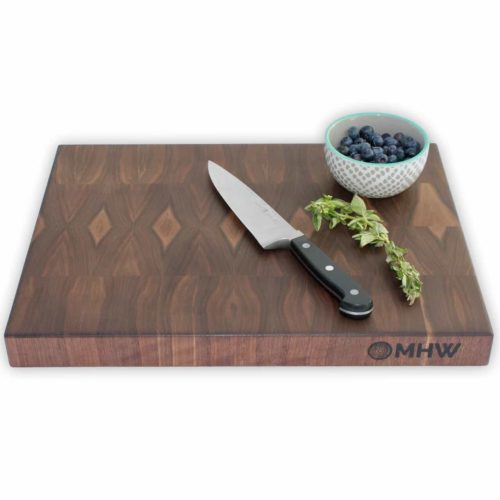Built Up to 2″ Thick | 30-Day Guarantee | Free Shipping
Shop by Wood Type
Our end grain custom butcher blocks are the “cream of the crop.” Built using sturdy wood blends, you will not find a butcher block built with the quality that MHW infuses in each board. We use wood blends of Walnut, Cherry and Maple. It’s time you make a statement in your kitchen with a custom wood butcher block from MHW. Our customers rely on the quality of our 2″ butcher blocks to last them a lifetime under the harshest conditions in their kitchen. Invest in Quality.
AS ANY CHEF WILL TELL YOU, YOU NEED A BUTCHER BLOCK IF YOU WANT TO CARVE YOUR OWN MEATS.
A butcher block affords you the stability a cutting board cannot offer. These wood butcher blocks offer you peace of mind as they are mainly used for meat preparation and not other food products.
Wood butcher blocks have an advantage over cutting boards. A wooden butcher block is made to handle tough and rough chopping, cutting and slicing. Butcher blocks are specifically designed with meat cutting in mind, so they are built safe and sturdy.
Top Selling Products
Wood Butcher Blocks
When it comes to selecting the best butcher block, the most important thing to pay attention to is the type of wood. The hardness of the wood you choose will ultimately impact the amount of life you can get from one butcher block. The harder the wood, the longer your butcher block will last.
All butcher blocks should come in end grain because they are more gentle on your knives and are self-healing. An end grain butcher block has a checkerboard-style appearance. And the slats of wood are held together by a food-safe adhesive.
| Type of Wood | Pros | Cons |
| Hardwoods | Allows for heavy-duty use and can withstand pressure to avoid dents and gouges you would see easily on softwoods. | Fewer hardwood options to choose from |
| Softwoods | Provides more options than hardwoods | Not the best for intense kitchen work; great as a decorative piece more than a functional chopping block |

Different Wood Types
No matter what type of wood you choose, you want to make sure it will serve you well. Keep the wood’s hardness in mind when purchasing your next butcher block.
The following list is comprised of the different types of woods we sell and their relative hardness:
- Cherry wood – Cherry is considered a hardwood. Brazilian cherry has the highest hardness rating on the Janka scale compared to other woods; American cherry ranks much lower on the scale.
- Maple wood – Maple is a hardwood that falls below Brazilian cherry wood but above American cherry wood on the Janka hardness scale. It offers a mid-range hardness that is good for butcher blocks.
- Walnut wood – Walnut is a type of softwood that can be used for butcher blocks. It ranks above American cherry on the Janka scale, so it is a good choice but might not last as long as your maple or Brazilian cherry butcher blocks.
Protect Your Investment
Our board butter is a great way to keep your butcher block in great condition for years; and is also 100% food-safe.

Cleaning And Maintaining Your Butcher Block
With a butcher block, you never want to soak it or run it in the dishwasher. This will irreparably damage the wood and can cause mold to grow. To clean a butcher block, you would clean it similarly to how you would cleanse a wooden cutting board.
Use the following steps to wash, dry, and sanitize your butcher block, keeping it clean and safe for years of use:
- Wash your butcher block. Wash with a mild soap and warm water. As mentioned above, do not soak your butcher block. Do not put your butcher block in the dishwasher; these pieces are hand wash only.
- Sanitize your butcher block. Using a mix of water and bleach, sanitize the butcher block. Use a ratio of bleach and water as listed on the bleach container.
- Rinse your butcher block. Rinse with warm water two or three times to ensure no soap or bleach is left behind.
- Dry your butcher block. Pat dry with a lint-free towel and set it upright to air dry.
Learn What Customers Think of Our Butcher Blocks
To maintain your butcher block for safe long term use, you will need to follow these next steps:
- Oil your butcher block – Use food-grade mineral oil and lint-free cloth to layer the oil on to the butcher block. Allow the oil to soak in 2 to 3 hours before the next use.
- Condition your butcher block – Try a conditioner with wax built-in to buff into the butcher block. Let sit overnight and then polish the butcher block using small circular motions.
It is good to note that some conditioners have mineral oil as part of their ingredient list. So, sometimes you can find a two-in-one product that allows you to combine the oiling and conditioning steps.
Read the labels of your products carefully to ensure they are food-grade. This means the product is safe for humans and will not cause any adverse health reactions when in contact with the food you will consume.
How to Remove Tough Stains From A Butcher Block
Stains are bound to happen, especially when dealing with red meats. But there is no need to worry. There are quite a few ways you can work to remove a stain from your butcher block. Try the following ways of stain removal before deciding to refinish the board with sandpaper.
The following is a list of kitchen items you can use to safely remove stains from your butcher block:
Lemon – Rub a cut lemon directly on to the stain and then rinse with soap and water. You can also soak your sponge in lemon juice and scrub lightly until the stain is removed.
Vinegar – If lemon does not work to remove the stain try coming back with some vinegar to wash the stain. Rinse with water after.
Soap – If lemon does not work to remove the stain try coming back later with soapy water to further reduce and remove the staining.
Baking soda – If lemon and soap do not work, or leave a fresh stain, try adding baking soda to the stain and letting it sit for a few minutes. Add vinegar for more harsh stain removal. Return with a sponge for cleaning.
Salt – If you are dealing with a tougher stain, sprinkle salt over the stain and then rub with a cut lemon or some lemon juice. Finish your cleaning process by cleaning your butcher block as normal.
If the stain is not removed after trying the above techniques, you can refinish your butcher block. You easily refinish a butcher block in two different ways:
Your butcher block is an investment and a tool that should be handled with the same care as your fancy knives. If you take the time to care for your butcher block, it will last you for years.
A butcher block is a great addition to any kitchen. Picking the right one for you is important! Choose a wood that suits your needs and then maintain it.
Latest Blog Posts
Frequently Asked Questions
All of our cutting boards are designed and built using locally sourced wood from multiple suppliers in the area. We are based in Nampa, Idaho and are proud to deliver our products to customers across the nation.
12-15 days is our normal turn-around time during non-peak times of the year such as the holidays. Because your cutting board will be handmade, we are confident that waiting approximately 2 weeks will be well worth it.
We ship using both UPS and FedEx. Depending on the size of the board, as well as the shipping destination, this helps us determine the best option to get it to you the quickest. All of our boards are carefully wrapped and packaged to avoid damage during shipping.
Most cutting boards you find at stores are mass-produced, and most of them made in China. Our products are not only handmade in the USA, but our boards are built up to 2 inches in thickness, which means the durability level is unmatched when compared to other brands.
Yes we do. Our cutting boards and butcher blocks come with a 30-day money back guarantee. Click here to read more about this.
View this profile on Instagram
Get A Custom Quote
Do you need a cutting board custom built to a specific size and specs?







